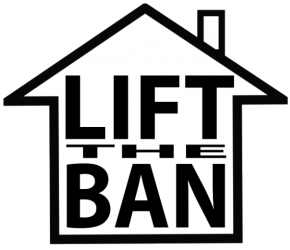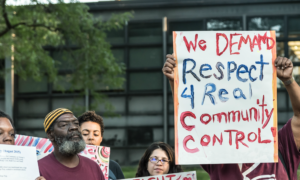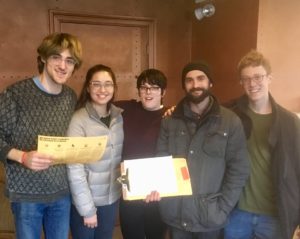Robin Peterson
Posted July 24, 2018

Ever since I attended my first DSA meeting more than a year ago, it’s been the question: What should DSA do?
Not that members of Chicago DSA are short on things to do. There’s an array of working groups to choose from, many doing creative and exciting projects; there are educational events, parties, actions, and plenty of meetings. But as an organization of more than 1,590 socialists in the city of Chicago—what should we collectively try to accomplish? What is our plan?
Without presuming to be able to answer that question on my own, I want to make a few observations and reflections on the referendum campaign that Chicago DSA finished leading up to the March 20 primary election as part of its work with the Lift the Ban Coalition. For those of us who organized for and led it, this campaign was one answer to the question “What should DSA do?” By asking how and why we undertook this campaign and to what extent we accomplished our internal goals, we can hopefully draw some lessons that will be useful for Chicago DSA and other DSA chapters in future campaigns, as well as help point a way forward in the fight for rent control.
Background on the Referendum Win
On March 20, voters in 77 precincts in Chicago got to weigh in on whether Illinois should lift the statewide ban on rent control, and more than 75 percent—12,178 people—said yes. The referendum appeared on the ballot through the efforts of the Lift the Ban Coalition, whose members have been fighting for rent control in Chicago since 2016. (The ban has been in place since 1997, when the corporate-funded group ALEC pushed it through the state legislature.) Chicago DSA became a member last September, when the Coalition began its petition drive to put the referendum on the ballot. In addition to sending members to canvass with two other Coalition partners—Pilsen Alliance and 33rd Ward Working Families—Chicago DSA also ran its own canvassing operation for two precincts in the 5th Ward. In those precincts, 11 and 18, the referendum passed with 77 percent and 83 percent support respectively.
Like all referenda in Chicago, except those regarding the sale of alcohol, the Lift the Ban referendum is non-binding. We set out to pass it by a large majority in order to show state legislators that voters overwhelmingly want to lift the ban—and that we have the capacity to turn them out to the polls. By all accounts, the Coalition succeeded at this first stage of the fight for rent control.
In the months since, we have gained a total of nine co-sponsors for SB3512, our bill for statewide rent control originally sponsored by State Senator Mattie Hunter. In May, the Coalition traveled to Springfield to educate legislators about the bill. Last month we joined forces with the Chicago Teachers Union and other groups fighting for an elected school board in Chicago to organize an action targeting Senate President John Cullerton—who has used his power to block both our bill and the elected school board bill. Chicago DSA has played an important role in this work. On the basis of our participation in the referendum campaign—which I will discuss in more detail below—Chicago DSA was voted into the Lift the Ban steering committee in April.
Coalition Building
Chicago DSA joined the Lift the Ban campaign as part of our effort to build relationships with other organizations who share our commitment to grassroots, bottom-up organizing that centers working-class people. This may sound like an obviously good thing to do, but it’s more important than just making friends: it’s been an essential first step to organizing for socialism in Chicago. I think it should be a priority for any DSA chapter in a place where such organizations exist.
One reason it’s so important is that DSA’s membership is, as a June 2017 Democratic Left post put it, “whiter, richer, and more masculine than the working class we’re working for.” The extreme segregation of Chicago makes this divergence particularly evident in the case of the South Side Branch. It probably also contributes to the fact that it is the smallest of Chicago’s three branches. These conditions have encouraged us on the South Side Steering Committee to prioritize making connections with other groups based in working-class communities on the South Side. Since taking office last June, the current Steering Committee has made it a practice to invite leaders of these organizations to speak at our branch meetings, and to meet with them one-on-one. The opportunity to join the Lift the Ban Coalition came about because of this practice.
In a city as rich with community organizations as Chicago, it would of course be foolish to intrude on anyone’s geographic “turf” without talking to them first. But avoiding stepping on toes is the least of what we have to gain from these conversations. DSA chapters should be deliberate about reaching out to groups that represent the self-organization of the working class and people of color and other oppressed peoples, because more often than not their fights will be ours.

The Lift the Ban Coalition is a great example. Of the four organizations on its steering committee—the Lugenia Burns Hope Center, Kenwood Oakland Community Organization, Northside Action for Justice, and Pilsen Alliance—all center low-income and working-class people, and three are based in neighborhoods that are majority people of color. The policy they are fighting for is one that curtails the profiteering of developers in the interest of working-class communities—a worthy goal for a socialist organization. In joining the fight for rent control, we have both grown Chicago DSA’s capacity and helped push the struggle forward. By targeting and winning our own precincts for the referendum, lending expertise in graphic design and social media, turning out members to actions, and showing up to coalition meetings, we’ve shown Chicago DSA to be a valuable, reliable coalition partner and paved the way for future collaboration on this and other campaigns.
We would never have accomplished all this if we hadn’t thought we had something to learn. This attitude is one we should hold on to going forward. With two new branches and a membership that has surged from 184 in October 2016 to more than 1,500 as of this month, Chicago DSA is—like many other chapters—a basically new organization. Of the thousand-plus members we’ve gained, many are new to organizing and political work. But we shouldn’t get so caught up in the exciting movement or interesting phenomenon that is DSA, that we forget that organizing is not new to Chicago. Rather, as we go forth to do something as DSA, we should be humble and receptive to the lessons we can learn from other organizations, without giving up any of our long-term ambitions or our ideological focus (which, lest we forget, are our strengths).
Capacity Building
The other big goal of the referendum campaign was to build the organizational capacity of Chicago DSA. Last September, most of our chapter’s projects and campaigns were happening at the working group level and, as a result, at the working group scale. As co-chair of the South Side Branch, I was looking for a potential campaign that would be big and broad enough for any branch—or chapter—member to plug into, in the form of a simple, not overly time-consuming, but rewarding and meaningful task (for example, a two-hour canvassing shift). Also, as someone with relatively scattered, minor organizing experience, and without a good sense of the organizing that was already happening on the South Side, I didn’t want to try to design a campaign from scratch. So when Pilsen Alliance invited Chicago DSA to collaborate with them on canvassing for the referendum, I decided, with the support of the other members of the South Side Steering Committee, to try to organize our branch and chapter to adopt the Lift the Ban campaign.

Looking back, I would say that we had a strong success in building Chicago DSA’s capacity with this campaign—with the caveat that I think we could have had even more success if the campaign had been taken up more broadly, at the chapter level. We ended up organizing it at the branch, and then the working group level, due to issues of timing and organizational structure.
In what ways did we build capacity? Starting last fall, the South Side Steering Committee learned how to build consensus around a campaign, and our membership participated in deliberative branch meetings in which we voted to adopt the campaign. Before the second, get-out-the-vote round of canvassing, the Housing Working Group did the same thing, and also wrote a comprehensive campaign proposal that included targets for turnout based on calculations of our win percentage goals. Dozens of Chicago DSA members learned how to canvass and had the experience of talking to folks about rent control on the doors, and several members trained and led their own canvass teams. A small core group learned to write a rap, plot canvass routes and enter information into the contacts database, and conduct turnout phonebanks for a total of about twelve canvasses. (University of Chicago YDSA and 33rd Ward Working Families shared turnout duties with the Housing Working Group.) We got to know the ins and outs of the two precincts in East Hyde Park that constituted our turf, and learned how to distinguish between good and bad turf. In February, we helped plan, execute, and debrief a direct action for rent control at the Thompson Center. We helped write the copy for the referendum campaign literature, and a very talented Housing Working Group member did the graphic design work (shoutout to Ben). On March 20, we ran an election day operation which began with flyering at 6 a.m. when the polls opened, and ended at 8:30 p.m. when the poll workers printed out the “tape” with the primary results.
We did a lot! And we ran most of the South Side-based campaign (the longer, more difficult get-out-the-vote phase) with a core group of only four people. However, many more people contributed to the campaign by canvassing, phonebanking, or flyering on election day and by helping to organize our first petition-drive canvass last fall to get the campaign off the ground.
Looking Ahead
One of the ways the referendum campaign fell short of its potential for Chicago DSA was in the lack of a clear plan for North Side members to plug in to. Starting this month, we will be running Lift the Ban canvasses in Logan Square in collaboration with other groups based in the area. We will also continue canvassing in Hyde Park, in order to build on the relationships we formed there during the referendum campaign, and to build outwards into other precincts in the neighborhood.
This summer and early fall, the Lift the Ban Coalition will hold four hearings on rent control, three of them in cities outside of Chicago. DSA’s network of chapters throughout the state has proven helpful in the process of planning these hearings. As we use the hearings to spread the word about rent control, pressure legislators, and expand our coalition throughout Illinois, we will hopefully lay the groundwork for a movement strong enough not only to pass rent control, but to take on Rahm, Rauner, Cullerton, Madigan, and the neoliberal power structures behind them.
Robin Peterson is a member of DSA and Solidarity in Chicago.
